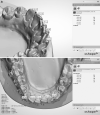Effect of low-level laser therapy on the time needed for leveling and alignment of mandibular anterior crowding
- PMID: 35344012
- PMCID: PMC9235377
- DOI: 10.2319/102721-795.1
Effect of low-level laser therapy on the time needed for leveling and alignment of mandibular anterior crowding
Abstract
Objectives: To assess the effect of low-level laser therapy (LLLT) on overall leveling and alignment time of mandibular anterior crowding and associated pain after initial archwire placement.
Materials and methods: Thirty-two females (18-25 years) with mandibular anterior crowding were randomly allocated into laser and control groups. Eligibility criteria included Angle Class I molar relationship and Little's irregularity index (LII) from 4 to 10 mm. Randomization was accomplished with a computer-generated random list. A 0.014-inch copper-nickel-titanium (Cu-NiTi) wire was inserted immediately after bonding of 0.022-inch Roth brackets followed by 0.016-inch Cu-NiTi, 0.016 × 0.022-inch NiTi then 0.017 × 0.025-inch stainless steel wire after completion of alignment. In-Ga-As laser was applied to the mandibular anterior segment in the laser group on days 3, 7, and 14, then at 1 month followed by every 2 weeks until completion of leveling and alignment. Visual analogue scale questionnaires were completed by each patient over 7 days from initial archwire placement. Digital models were used to monitor changes in the irregularity index. Blinding was applicable for outcome assessors only.
Results: The mean time for leveling and alignment was significantly lower in the laser compared to the control group (68.2 ± 28.7 and 109.5 ± 34.7 days, respectively). The laser group displayed a significantly higher mean alignment improvement percentage as well as lower pain scores compared to the control group.
Conclusions: Within the constraints of the current study, LLLT has a potential for acceleration of anterior segment alignment as well as reduction of the pain associated with placement of initial archwires.
Keywords: Acceleration; Alignment; Irregularity index; LLLT; Pain; Tooth movement.
© 2022 by The EH Angle Education and Research Foundation, Inc.
Figures
References
-
- Yi J, Xiao J, Li H, Li Y, Li X, Zhao Z. Effectiveness of adjunctive interventions for accelerating orthodontic tooth movement: a systematic review of systematic reviews. J Oral Rehabil . 2017;44(8):636–654. - PubMed
-
- Gravina MA, Brunharo IH, Fraga MR, et al. Clinical evaluation of dental alignment and leveling with three different types of orthodontic wires. Dental Press J Orthod . 2013;18(6):31–37. - PubMed
-
- Proffit WR, Fields HW, Jr, Moray LJ. Prevalence of malocclusion and orthodontic treatment need in the United States: estimates from the NHANES III survey. Int J Adult Orthodon Orthognath Surg . 1998;13(2):97–106. - PubMed
-
- Gibreal O, Hajeer MY, Brad B. Efficacy of piezocision-based flapless corticotomy in the orthodontic correction of severely crowded lower anterior teeth: a randomized controlled trial. Eur J Orthod . 2019;41(2):188–195. - PubMed
Publication types
MeSH terms
Substances
LinkOut - more resources
Full Text Sources
Medical
Research Materials




